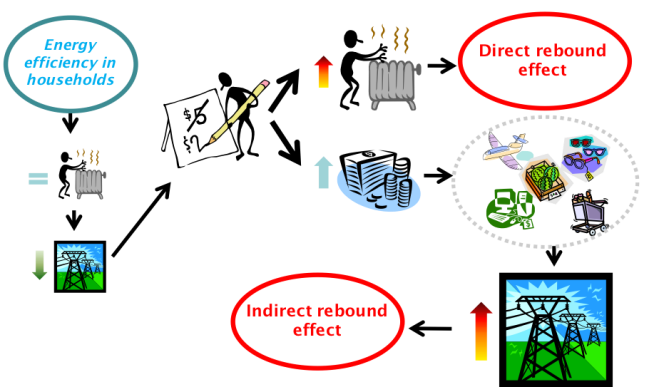Jaume Freire | ENT – Harvard University
Energy efficiency is misunderstood by many policy-makers, despite the large amount of scientific studies trying to explain how it works at micro and macroeconomic levels. At policy level, the effect of energy efficiency measures is mostly estimated through the use of engineering calculus. Let’s start with an example. Suppose that the government initiates an investment plan to improve isolation at households. This measure will improve the efficiency in providing heating and cooling (known as energy services), less effort will be needed to provide the same amount of these energy services. Government technicians roughly estimate the efficacy of this measure in terms of new energy consumption by estimating how much isolation material will be purchased with the funds and what is the actual isolation provided by this material in a controlled environment. This would be quite accurate in a single timeless dwelling without intelligent life living in it. However, social sciences show us this is not the way it works.

This is known as rebound effect among economists and social scientists. They all agree on its existence; the discussion is on how large it is. Policy-makers have to be aware of this effect, start conducting rigorous assessments on energy efficiency measures and implement additional measures to control it if they want to fight climate change.
Freire-González, J., Puig-Ventosa, I., 2015. Energy Efficiency Policies and the Jevons Paradox. International Journal of Energy Economics and Policy 5(1), 69–79.
Jevons, W. S., 1865. The Coal Question. London: Macmillan and Co.
Ruzzenenti, F., Basosi, R., 2008. The rebound effect: An evolutionary perspective. Ecological Economics 67, 526–537.
Saunders, H.D., 1992. The Khazzoom-Brookes Postulate & Neoclassical Growth. The Energy Journal 13(4), 131–148.
Sorrell, S., 2007. The rebound effect: an assessment of the evidence for economy-wide energy savings from improved energy efficiency. UK Energy Research Centre.
[catala][castellano][english][fi_idiomes][/fi_idiomes]

